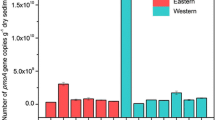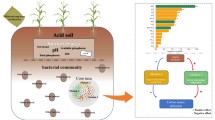Abstract
The Hoh Xil basin is the largest Cenozoic sedimentary basin in the Qinghai–Tibet Plateau (QTP) with an average altitude of above 5000 m. It is also the coldest region in the QTP. However, due to the difficulty of sample collection caused by the harsh natural environment, a limited number of studies have been conducted on soil microorganisms in this region. We used culture-dependent and independent methods to investigate the bacterial communities in desert soil (n1), saline–alkali land (n2), saline–alkali wetland (n3), and soda lake sediment (n4). The results showed distinct bacterial communities between different environmental types. We found that the Chao1 and Shannon diversity indices of n1 were significantly lower than those of n4 (P < 0.05). At the phylum level, all samples were dominated by representatives of Proteobacteria, Bacteroidetes, and Actinobacteria, which were similar to the findings of previous studies on the desert soil in the same region. Moreover, we identified 10 strains of bacteria from 109 isolates, most of which belonged to Pseudomonas (90.8%). The growth of the isolate k9 was optimal at a high pH value (pH 10.0) and a low temperature (5 °C), and this stain could produce extracellular enzyme (alkaline phosphatase, acid phosphatase, and naphthol-AS-BI-phosphohydrolase) under alkaline (pH 10) and cold (5 °C) condition. These results demonstrate the diversity of bacteria in the Hoh Xil basin and identify potential psychrophilic and alkaliphilic bacteria with multiple types of extracellular enzyme activity.






Similar content being viewed by others
References
Caporaso JG et al (2010) QIIME allows analysis of high-throughput community sequencing data. Nat Methods 7:335–336
Caporaso JG et al (2011) Global patterns of 16S rRNA diversity at a depth of millions of sequences per sample. Proc Natl Acad Sci U S A 108:4516–4522
Cavicchioli R, Charlton T, Ertan H, Mohd OS, Siddiqui KS, Williams TJ (2011) Biotechnological uses of enzymes from psychrophiles. Microb Biotechnol 4:449–460
Chu H, Sun H, Tripathi BM, Adams JM, Huang R, Zhang Y, Shi Y (2016) Bacterial community dissimilarity between the surface and subsurface soils equals horizontal differences over several kilometers in the western Tibetan Plateau. Environ Microbiol 18:1523–1533
Dixon P (2003) VEGAN, a package of R functions for community ecology. J Veg Sci 14:927–930
Duckworth AW, Grant WD, Jones BE, Steenbergen R (1996) Phylogenetic diversity of soda lake alkaliphiles. FEMS Microbiol Lett 19:181–191
Edgar RC (2010) Search and clustering orders of magnitude faster than BLAST. Bioinformatics 26:2460–2461
Feller G (2013) Psychrophilic enzymes: from folding to function and biotechnology. Scientifica. https://doi.org/10.1155/2013/512840
Fujinami S, Fujisawa M (2010) Industrial application of alkaliphiles and their enzymes—past, present and future. Environ Technol Environ Technol 31:845–856
Green JL, Bohannan BJM, Whitaker RJ (2008) Microbial biogeography: from taxonomy to traits. Science 320:1039–1043
Hall TA (1999) BioEdit: a user-friendly biological sequence alignment editor and analysis program for Windows 95/98/NT. In. Nucl Acids Symp 41:95–98
Horikoshi K (1999) Alkaliphiles: some applications of their products for biotechnology. Microbiol Mol Biol Rev Mmbr 63:735–750
Huse SM, Huber JA, Morrison HG, Sogin ML, Welch DBM (2007) Accuracy and quality of massively parallel DNA pyrosequencing. Genome Biol 8:149–155
Jeanmougin F, Thompson JD, Gouy M, Higgins DG, Gibson TJ (1998) Multiple sequence alignment with Clustal X. Trends Biochem Sci 23:403–405
Kumar S, Stecher G, Li M, Knyaz C, Tamura K (2018) MEGA X: molecular evolutionary genetics analysis across computing platforms. Mol Biol Evol 35:1547–1549
Liu S, Zhao H, Dong S, Nannan AN, Xukun SU, Zhang X (2014) Climate changes in the alpine grassland nature reserves on Qinghai-Tibet Plateau in recent 50 years based on SPEI Index. Ecol Environ Sci 23:1883–1888
Lozupone CA, Knight R (2005) UniFrac: a new phylogenetic method for comparing microbial communities. Appl Environ Microbiol 71:8228–8235
Mago T, Salzberg SL (2011) FLASH: fast length adjustment of short reads to improve genome assemblies. Bioinformatics 27:2957–2963
Parks DH, Tyson GW, Hugenholtz P, Beiko RG (2014) STAMP: statistical analysis of taxonomic and functional profiles. Bioinformatics 30:3123–3124
Puspita ID, Kamagata Y, Tanaka M, Asano K, Nakatsu CH (2012) Are uncultivated bacteria really uncultivable? Microbes Environ 27:356–366
Simankova MV, Kotsyurbenko OR, Lueders T, Nozhevnikova AN, Wagner B, Conrad R, Friedrich MW (2003) Isolation and characterization of new strains of methanogens from cold terrestrial habitats. Syst Appl Microbiol 26:312–318
Stackebrandt E, Goodfellow M (1991) Nucleic acid techniques in bacterial systematics. John Wiley and Sons, Hoboken
Stougaard P, Jorgensen F, Johnsen MG, Hansen OC (2002) Microbial diversity in ikaite tufa columns: an alkaline, cold ecological niche in Greenland. Environ Microbiol 4:487–493
Struvay C, Feller G (2012) Optimization to low temperature activity in psychrophilic enzymes. Int J Mol Sci 13:11643–11665
Su j-jZ, Yu-Qin, SUN, Ying, Sun Y (2011) Diversity of culturable and unculturable bacteria in soil samples from Hoh Xil, China. Microbiology China 38:1473–1481
Sun YS, Jing-jing, Liu, Chao, Wei, Yu-zhen, Yu, Li-yan (2011) Isolation and biological characterization of the bacteria from the alkaline soil of Hoh Xil. Microbiol China 38:1473–1481
Tang L, Shen C (1996) Late Cenozoic vegetational history and climatic characteristics of Qinghai-Xizang Plateau. Acta Micropalaeontol Sin 13:321–338
Valenzuela-Encinas C, Neria-González I, Alcántara-Hernández RJ, Estrada-Alvarado I, Fj ZDDLS, Dendooven L, Marsch R (2009) Changes in the bacterial populations of the highly alkaline saline soil of the former Lake Texcoco (Mexico) following flooding. Extremophiles 13:609–621
Vester JK, Glaring MA, Stougaard P (2014) Discovery of novel enzymes with industrial potential from a cold and alkaline environment by a combination of functional metagenomics and culturing. Microb Cell Factories 13(1(2014-05-20) 13):72–72
Wang J et al (2013) Phylogenetic beta diversity in bacterial assemblages across ecosystems: deterministic versus stochastic processes. ISME J 7:1310–1321
Wang XY, Liu GH, Liu B, Chuan-Qing R, Chen Z (2017) Survey of alkaliphilic Bacillus-like resources in Kekexili, Qinghai. Microbiol China 8:1847–1857
Wen X, Yi G, Xu X (2007) Background and precursory seismicities along and surrounding the Kunlun fault before the 8.1, 2001, Kokoxili earthquake, China. J Asian Earth Sci 30:63–72
Zhilina TN, Zavarzin GA (1994) Alkaliphilic anaerobic community at pH 10. Curr Microbiol 29:109–112
Funding
This work was supported by the National Natural Science Foundation of China (No. 31600409), the Open Project of Qinghai Provincial Key Laboratory of Crop Molecular Breeding (2017-ZJ-Y14), the CAS “Light of West China” Program, the National Science and Technology Foundation Project (2015FY110100), and the Strategic Priority Research Program of Chinese Academy of Sciences (XDA2005010406).
Author information
Authors and Affiliations
Corresponding author
Ethics declarations
Conflict of interest
The authors declare that they have no conflict of interest.
Research involving human participants and/or animals
This article does not contain any studies with human participants or animals performed by any of the authors.
Informed consent
Informed consent is not required in this study.
Additional information
Publisher’s note
Springer Nature remains neutral with regard to jurisdictional claims in published maps and institutional affiliations.
Electronic supplementary material
ESM 1
(DOC 6324 kb)
Rights and permissions
About this article
Cite this article
Xing, R., Gao, Qb., Zhang, Fq. et al. Bacterial community in cold and alkaline environments of Hoh Xil basin in Qinghai–Tibet Plateau and isolation of potential sources of microbiota. Ann Microbiol 69, 567–576 (2019). https://doi.org/10.1007/s13213-019-01447-w
Received:
Accepted:
Published:
Issue Date:
DOI: https://doi.org/10.1007/s13213-019-01447-w




